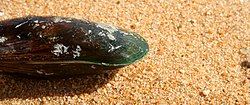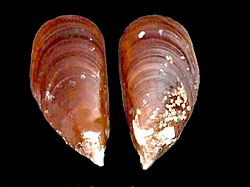| Perna | |
|---|---|
 | |
| Perna canaliculus, the New Zealand mussel | |
| Scientific classification | |
| Domain: | Eukaryota |
| Kingdom: | Animalia |
| Phylum: | Mollusca |
| Class: | Bivalvia |
| Order: | Mytilida |
| Family: | Mytilidae |
| Genus: | Perna |
| Species | |
See text | |
| Synonyms [1] | |
Chloromya Mörch, 1853 | |
Perna is a genus of mussels, marine bivalve molluscs in the family Mytilidae. [1]
Contents
Not to be confused with PernaBruguière, 1789 , synonym of Isognomon Lightfoot, 1786
